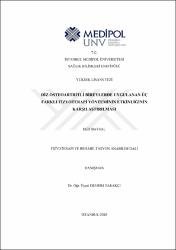| dc.contributor.advisor | Tarakçı, Devrim | |
| dc.contributor.author | Baysal, Elif | |
| dc.date.accessioned | 2021-06-21T11:46:14Z | |
| dc.date.available | 2021-06-21T11:46:14Z | |
| dc.date.issued | 2018 | en_US |
| dc.date.submitted | 2018-06-22 | |
| dc.identifier.citation | Baysal, E. (2018). Diz osteoartritli bireylerde uygulanan üç farklı fizyoterapi yönteminin etkinliğinin karşılaştırılması. (Yayınlanmamış yüksek lisans tezi). İstanbul Medipol Üniversitesi Sağlık Bilimleri Enstitüsü, İstanbul. | en_US |
| dc.identifier.uri | https://hdl.handle.net/20.500.12511/7246 | |
| dc.description.abstract | Osteoartrit (OA), primer olarak ilerleyici kıkırdak yıkımıyla sonuçlanan dünyada en sık karşılaşılan romatolojik hastalıktır. En çok diz ekleminde görülür. Çalışmamızda diz OA' lı bireylere uygulanan üç farklı fizyoterapi yönteminin eklem hareket açıklığı (EHA), kas kuvveti, ağrı ve yaşam kalitesi üzerine etkilerinin araştırılması amaçlandı. Diz OA tanılı 40-65 yaş aralığında 30 hasta çalışmaya dahil edildi ve 3 gruba ayrıldı. Klasik FTR grubuna (n=10) 15 seans ultrason (US), transkutenöz elektriksel sinir stimülasyonu (TENS), hotpack veya coldpack ve ev egzersiz programı uygulandı. Trombositten zengin plazma (PRP) grubuna (n=10) üç doz PRP uygulaması sonrası 15 gün boyunca ev egzersiz programı uygulandı. Kontrol grubuna (n=10) 15 gün boyunca sadece ev egzersiz programı uygulandı. Bireyler tedavi öncesi ve sonrası fiziksel aktivite düzeyi 'WOMAC Skalası', eklem hareket açıklığı (EHA) 'gonyometre', quadriceps kas kuvveti 'manuel kas testi', ağrı 'Visüel Analog Skala' ve yaşam kalitesi 'SF-12 Yaşam Kalitesi Ölçeği' kullanılarak değerlendirildi. Uygulamalar sonucunda her 3 grupta da aktivite anındaki ağrı ve WOMAC skorunda, klasik FTR ile egzersiz ve PRP sonrası egzersiz grubunda EHA ve SF-12 MCS skorunda, kontrol grubunda ise istirahat anındaki ağrı ve SF-12 PCS skorunda istatistiksel olarak anlamlı fark bulundu (p<0,05). Bulgularımız, diz OA tedavisinde kullanılan terapötik yöntemlerin semptomları azaltma ve yaşam kalitesini arttırma üzerinde etkili olduğunu göstermektedir. Sonuç olarak, klasik FTR tedavisi ile birlikte verilen ve PRP uygulaması sonrası ilave edilen ev egzersiz programının diz OA' da hastalığın semptomları gidermek ve yaşam kalitesini arttırmak için kullanılabileceği düşünülmektedir. | en_US |
| dc.description.abstract | Osteoarthritis (OA) is the most common rheumatological disease in the world that results in progressive destruction of cartilage. It is most commonly seen in the knee joint. The purpose of this study was to investigate the effects of three different physiotherapy methods applied to individuals with knee osteoarthritis, joint range of motion (ROM), muscle strength, pain and quality of life. 30 patients (40-65 years) diagnosed with knee OA were included in the study; the participants were divided into three groups. In the classical FTR group (n = 10) 15 sessions of ultrasonography (US), transcutaneous electrical nerve stimulation (TENS), hotpack or coldpack and home exercise program were applied. The platelet rich plasma (PRP) group (n = 10) received three doses of PRP followed by home exercise program for 15 days. For the control group (n = 10), only home exercise program was applied for 15 days. Before and after the treatment the participants physical activity levels 'WOMAC Scale', joint range of motion 'Goniometer', quadriceps muscle strength 'manuel muscle testing', pain scale 'Visual Analog Scale' and quality of life 'SF-12 Quality of Life Scale' were measured. Our findings suggest that there was a statistically significant difference among three groups in the pain during activity and WOMAC score, between the classical FTR groups and PRP group in the ROM and SF-12 MSC score, in the control group in pain at rest and SF-12 PCS score (p<0,05). Our findings show that the therapeutic methods used in the treatment of knee OA are effective in reducing symptoms and increasing quality of life. In conclusion, it can be said that the home exercise program which is given with the classic FTR treatment and added after the PRP application can be used to relieve the symptoms and improve the quality of life in the knee OA. | en_US |
| dc.language.iso | tur | en_US |
| dc.publisher | İstanbul Medipol Üniversitesi Sağlık Bilimleri Enstitüsü | en_US |
| dc.rights | info:eu-repo/semantics/openAccess | en_US |
| dc.subject | Diz Osteoartrit | en_US |
| dc.subject | Ev Egzersiz Programı | en_US |
| dc.subject | Klasik FTR | en_US |
| dc.subject | PRP | en_US |
| dc.subject | TENS | en_US |
| dc.subject | Ultrason | en_US |
| dc.subject | Classic FTR | en_US |
| dc.subject | Home Exercise Programme | en_US |
| dc.subject | Knee Osteoarthritis | en_US |
| dc.subject | PRP | en_US |
| dc.subject | TENS | en_US |
| dc.subject | Ultrasound | en_US |
| dc.title | Diz osteoartritli bireylerde uygulanan üç farklı fizyoterapi yönteminin etkinliğinin karşılaştırılması | en_US |
| dc.title.alternative | Comparison of the effectiveness of three different physiotherapy methods among individuals wi̇th osteoarthritis | en_US |
| dc.type | masterThesis | en_US |
| dc.department | İstanbul Medipol Üniversitesi, Sağlık Bilimleri Enstitüsü, Fizyoterapi ve Rehabilitasyon Ana Bilim Dalı | en_US |
| dc.relation.publicationcategory | Tez | en_US |


















